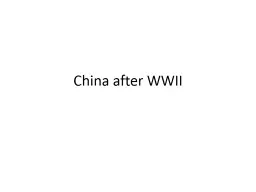

1950s1970s China Under Mao KMT led by Chiang KaiShek flees to Taiwan 1958 1961 Great Leap Forward five year economic plan labor intensive collective farming GLF abandoned after two years widespread famine ID: 627503
Download Presentation The PPT/PDF document "China, Iran, Northern Ireland" is the property of its rightful owner. Permission is granted to download and print the materials on this web site for personal, non-commercial use only, and to display it on your personal computer provided you do not modify the materials and that you retain all copyright notices contained in the materials. By downloading content from our website, you accept the terms of this agreement.
Slide1
China, Iran, Northern Ireland
1950s-1970sSlide2
China Under Mao
KMT led by Chiang Kai-Shek flees to Taiwan
1958 – 1961 Great Leap Forward – five year economic plan, labor intensive, collective farming
GLF abandoned after two years, widespread famineSparrow-killing led to locusts1966-76 Cultural Revolution – ideological campaign, anti-intellectualism, anti-West, burnings, promoted revolutionary ideasJiang Qing (Mao’s wife) was cultural advisorMao’s Little Red BookRed Guard – anti-west policeSlide3
Opening Up of China
Ping-Pong
Diplomacy – first Americans to visit since 1949
1972 – Nixon secretly visits, relations with USA normalized1976 – Mao dies, Gang of Four (including Jiang Qing) jockey for powerGang of Four arrested for trying to usurp power, put on trial in 1981 for anti-party activities1977 – 1997 – Deng Xiaoping, “Beijing Spring”Deng encouraged criticism of Cultural Revolution (30,000 people died), worked with Eight Elders, never held title of General Secretary, more open to West
Jan. 1, 1979 – USA officially recognizes ChinaSlide4
Iran: WWI to WWII
Persia is officially neutral during WWI
1923 - Reza Khan becomes PM
1925 – parliament votes Khan ruler, previous shah deposed, he is crowned Reza Shah Pahlavi, Mohammad Reza is crown prince1935 – Persia changes name to Iran1941 – UK and Russia occupy pro-Axis Iran, Reza Shah deposed and Mohammad Reza made shahSlide5
Iran-Iraq War, 8 Years
September 1980 – Iraqi president Saddam Hussein invades Iran
Hussein afraid of Iran inciting Shia minority in Iraq
Iraq used ballistic missiles on cities and chemical weapons against Iran and Iraqi Kurds thought to be allied with IranIraq supported by Saudi Arabia, Kuwait, USA and USSRIran supported by Libya and SyriaJuly 1988 – Iran accepts UN mediated cease-fireSlide6
Mossadeq and the Shah
1950 – Ali
Razmara
made PM, assassinated nine months laterNationalist Mohammed Mossadeq new PM, anti-West (like Nasser in Egypt)1951 – Iran nationalizes oil industry, UK embargo and blockadePower struggle between Shah and Mossadeq, Shah flees country
1953 - US and UK intelligence organize coup (Operation Ajax), Mossadeq forced out, General Zahedi new PM, Shah
returns, Mossadeq died in house arrestWhite Revolution – Shah’s social and economic modernization campaign, westernizing countrySAVAK – Shah’s secret police
1964 – Ayatollah Khomeini exiledSlide7
The Islamic Revolution in Iran
Iran mostly Shia Muslim
1978
– authoritarian rule leads to riots, Muslim clergy angryRoyal family forced into exileApril 1979 – Islamic fundamentalists led by Ayatollah Khomeini (returning from exile) proclaim Islamic Republic of IranNov 1979 – Islamic militants take 63 American hostages from US embassy, demand return of the Shah from US to face trialJan 1980 – prisoners freed after 444 days
“Argo”July 1980 – Shah dies in exile in EgyptSlide8
The Troubles: 1968-1998 Northern Ireland
Unionists dominated Northern Irish parliament since WWI
Violence grew between Unionist Protestants and Republican Catholics
1971 – Internment policy by N. Irish govt agsint terrorists1972 “Bloody Sunday” – Londonderry demonstration ends with 13 killed by British army1972 – London imposes direct ruleSlide9
Attempts at peace (many failed)
1973 –
Sunningdale
Agreement – power sharing in govt and Ireland would have role in Northern Ireland (collapsed in 1974)1985 – Ango-Irish Agreement (moderate), both extremes hated itSinn Fein vs. UnionistsSinn Fein – political wing of the Irish Republican ArmySlide10
Good Friday Agreement 1998
Talks began in 1996
Pres. Bill Clinton sent Sen. George Mitchell to chair the talks
Agreement set up power-sharing in N. Ireland parliamentIreland drops claims to the six counties in N. IrelandDecommissioning of weapons in paramilitary orgs.End of “The Troubles”…sort ofOrange Order marches (Unionists)2007 St. Andrew’s Agreement amended GFA